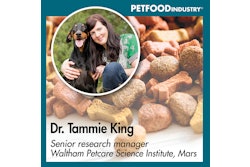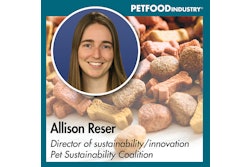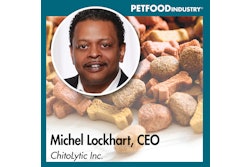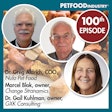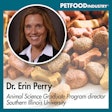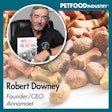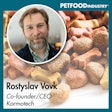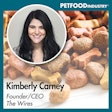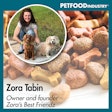
This episode of Trending: Pet Food focuses in on game meats like ostrich and springbok that offer high protein content, low fat, and natural sourcing — traits that set them apart from conventional meats and appeal to both pet palates and consumer preferences for clean-label formulations.
The transcript below is from Episode 87 of the Trending: Pet Food podcast, where host Lindsay Beaton and Angelique Myburgh, nutrition and development manager at Montego Pet Nutrition, dive into African game meat as a novel protein. You can find the episode at Trending: Pet Food Podcast, on SoundCloud or on your favorite podcast platform. This episode was recorded at Petfood Forum 2025 in Kansas City, Missouri, U.S., on April 29.
We want to thank Coperion for sponsoring this podcast. Coperion brings together some of the world's most trusted technology brands to offer innovative system and ingredient automation solutions to pet food producers worldwide.
Lindsay Beaton, editor, Petfood Industry magazine and host, Trending: Pet Food podcast: Hello, and welcome to Trending: Pet Food, the industry podcast where we cover all the latest hot topics and trends in pet food. I’m your host and editor of Petfood Industry magazine Lindsay Beaton, and I’m here today live on the Petfood Forum 2025 show floor, with Angelique Myburgh, nutrition and development manager at Montego, as well as a Petfood Forum speaker this year. Hi Angelique, and welcome!
Angelique Myburgh, nutrition and development manager at Montego Pet Nutrition: Hi Lindsay. It's nice meeting you.
Beaton: In case you’re unfamiliar with Angelique or Montego, here’s what you need to know.
Angelique is a registered professional in animal science with master’s and bachelor’s degrees in agricultural animal science from the University of Stellenbosch, plus a certificate in canine and feline nutrition from the University of Southern Illinois. Her career includes research focused on plains zebra meat quality, leading to a 2023 publication and future work in the same domain. As the nutrition and development specialist at Montego Pet Nutrition, Angelique specializes in pet food development across various formats, including dry, wet, and semi-moist products, with a strong focus on innovation, sustainability, and nutritional excellence.
Montego Pet Nutrition was established in early 2000 in Graaff-Reinet, South Africa, the heart of the Karoo. Built upon a strong foundation of entrepreneurial spirit, family values, quality and innovation, Montego is now Africa’s leading pet food company.
Angelique’s unique perspective on novel proteins and international experience are why I’ve brought her on today to answer this question: What are the uses of game meat as novel proteins in pet food formulations?
Angelique, I want to start with a bit of a 101 question, so we know what kind of protein we're talking about here. What exactly qualifies as game meat and what options are currently even in use in pet food and treats?
Myburgh: That's a great starting question. There is a confusion between the terms “game meat” and “venison meat.” It is used interchangeably, even in South Africa. The big difference between the two is that venison meat is normally deer and elk, which you can find in the USA, but you also find it in New Zealand, where they produce it more intensively for meat production.
Game meat, on the other end, contains a lot more species in the category. It can be African antelopes such as springbok, impala, kudu, oryx, and even wildebeest, just to name a few. It can also include other species, such as zebras and buffalo, it can be warthog. If you go according to the ATS code, it also includes ostrich meat.
What we're seeing in South Africa is there's a lot of products that contain ostrich. But for us, specifically, because of the back story, we do use springbok and antelope. We've got a product called Karu Wild where we use the antelope meat, which is mostly springbok, that is new to the market. Then ostrich, you get in at different formats as well.
Beaton: We're going to get into springbok and your specialties, but what is it about ostrich meat that makes it good? Is it particularly high in protein? Is it very palatable? What's special about ostrich meat that makes it popular?
Myburgh: It's the same as game meat. It's very lean, low in fat, high in protein. It's got that gamey, unique flavor to it that's appealing to dogs. It’s the same with springbok. They all have this gamey tinge to it. The only way I can really explain it to you is that it's got this liver, like metallic, flavor to it, and that's attractive to pets.
Because game meat, for instance antelope, they roam freely. They're not fed any extra feed. They are natural vegetations. It's a much more natural type of meat than a product that comes out of a feedlot. It’s the same with ostrich, even though they do follow more conventional livestock practices for ostrich production. It's also a much cleaner product now.
Beaton: The more conventional proteins, like chicken, beef, pork, are very much in competition with the human space as well, because we consume the same proteins. When it comes to game proteins, are they also in the same level of competition in the human space? Or are they used more in the pet space than in the human space?
Myburgh: It's much more in the human space. Game meat is still very niche. It's part of our culture. It's part of our culinary heritage. A lot of families go hunting for meat, for biltong, which is very similar to jerky. The way they make it is a little bit different. It's dried meat. A lot of households will do it, but you will now start to see game meat in retail stores for purchase. But it's still very niche, very novel, and it's normally like a family event. You go on a hunting trip to get this product or this meat, then you process it or send it to an abattoir, and they process it for you. Now, you'll be seeing it more in the human food space.
What makes it then special is people have that connection with springbok and antelope. Now, seeing it on shelf in a pet food store, they are attracted to it, and because it's authentic like back home, they have a feeling for it, which is great.
Beaton: You mentioned that these types of proteins tend to forage naturally, so they don't necessarily need supplementary feeding, like you would with chickens or cows, which we feed through agricultural animal feed. How are these animals farmed, if they're farmed at all, or is it more of a hunting experience? And on top of that, any of the game proteins considered invasive species, and is that one of the reasons that they are used in pet food?
Myburgh: They're noninvasive species. It's the other way around. They are a South African animal, and there's a whole backstory to it. To quickly unpack that, early 2000 the game meat industry was really thriving. You were able to export fresh, frozen game meat. Then in 2011, there was that export ban, which caused the farmers not to be able to export this meat anymore.
You can just imagine the impact that it had on their livelihoods, as well as the impact that it had on the local communities. This also influenced the population of the springbok, especially the Karoo area. It went down because they didn't diversify their livestock farming with it anymore. That's where we come in.
South Africa has a game meat strategy, which they published in 2023. The strategy is to commercialize the game meat industry again, to bring the volumes up. As I mentioned in my speech yesterday, they didn't even consider pet food. They just missed the pet food industry. We are the perfect industry to use game meat in pet food products. We then can export it because we are processing it, so that gives us a big advantage.
Beaton: Given how important that type of protein was and is to farmers in the area, exactly, how are they farmed?
Myburgh: They're kept on their farms, but they're extensively farmed, so not intensively at all. They feed on natural vegetation. They are free roaming. They do have regenerative properties, and they will only be given supplemental licks or feed if the field is really struggling in very severe drought conditions. These antelopes or game meat are very hardy animals. They are resilient, so they don't need a lot of feed, and they don't need a lot of water. That makes them a perfect addition to a farm, especially in the Karoo area, because they are naturally inclined to survive there.
Beaton: Given Montego's values and the fact that it's a large pet food company in Africa and in South Africa, specifically, how important is helping to revitalize the community through wild game agriculture to Montego? When did it decide to take up that mantle and come up with this plan to help the farmers get this type of protein back out there as an option in pet food?
Myburgh: That's such a beautiful question. The head office of Montego is situated in the heart of the Karoo, so they saw it firsthand happening around them. There were even abattoirs that existed just for exports, and they have closed because of this ban. Being in the midst of it, seeing what is happening, and knowing that we also want to bring a novel protein to the pet food space, we got this – what we call a BHAG – a big, hairy, audacious goal.
Our goal is to make Africa a pet food continent as well, because we're so small in the pet food space. We saw that Africa can bring a novel protein to the table, so that Africa can play a critical role in it. Then it has this extra benefit to support our farmers, our communities and further help the springbok population.
We've got this core purpose that we live by, and we really take that into consideration with every decision that we need to make, even in product development. That’s to better our own society and our industry every day. I think using African game meat speaks to that core purpose, and that's what we're doing.
Beaton: We've talked about the ban a little bit. I was wondering if you can go into more specifics for people who might not be familiar with what happened, then we can lead into talking about some of the challenges that Africa, as a continent, faces in terms of growing influence in the pet food space.
Myburgh: At the onset of the 20th century, game meat was recognized as a market, but it still had to secure its valuable position in the agricultural sector in South Africa, as it stands today. By that time, there was already one species and two subspecies of mammals that were extinct due to uncontrolled hunting in the late 1800s. These species and subspecies were the bluebuck, the quagga, which is like a zebra, and the cave lion. There were other species that were also endangered, for example, the black wildebeest, which is such a big species in our country now, and the bontebok as well the cape mountain zebra.
They believed back in the day that game was a carrier of disease for their livestock, which is untrue. By the 1950s, after the World War, they rationed game meat as a commodity, and that's where the interest really sparked in game meat. With the increase in total landowners, the game numbers started to stabilize. Way back, they called game as res nullius, meaning no one could own game. Today, you can own game and help with the population. You can do controlled harvesting. But way back, you would have just hunted, which obviously had a severe impact on it.
Even as the game numbers started to stabilize, the International Union for Conservation of Nature held a conference on game farming in 1953, which helped tremendously. Then the South African Hunting and Game Conservation Association became a national association in 1957.
By the 1960s, there was a progressive increase in the size of the game industry. This resulted in increased interest by scientists and aspects to game farming. From there it went very well. They actually allocated a few pillars, and these pillars for game farming in general, linked to ecotourism and meat production, such as making the biltong. That was most of the pillars and how the farmers started including these springbok and other antelope on their farms. It went well. We were one of the top exporters way back.
The ban came because of the spread of hoof-and-mouth disease in our country. It caused the borders to close for us, and that had such a bad effect on the whole industry, and the numbers went down.
I would say the industry really collapsed by 2017. That's when the abattoirs started closing, and they could only produce game meat locally. There's more to it, but that's just an overview of the game meat industry and where we stand today.
We do have other avenues. Ecotourism is very big in South Africa. People come from overseas to see the animals. We have options as well, of these animals to grow the populations and to do a lot of color variants as well, to see if we can get a white springbok or a copper springbok.
There's a lot of innovations in animal breeding. We’ve got such a diverse population of game species. But in a nutshell, that is what was happening in the game meat industry. Now, to overcome it they’ve published this game meat strategy, added these multiple avenues -- and doesn't just stop at volumes. It has other goals as well, such as increasing job creation in the game meat sector. Currently, they're building on 100,000-plus jobs in the game meat industry, and they want over 200,000 by 2030, which is just around the corner. They are doing well on that goal. They also want to support previously disadvantaged individuals by adding 2.7 million acres of community-owned land for the purpose of game meat production. We anticipate that we will have economic growth and will create more jobs, especially in game ranching, meat processing sales, just to name a few.
Beaton: Now, obviously not everybody has heard of these animals. When you're presenting a product and it has a protein that's unfamiliar … one of the big things about novel proteins is, depending on what it is, it requires a lot of education, even down to, is this a good protein source? What does it taste like? Pet owners want to know those types of things.
I'm assuming, within South Africa, people know what these animals are, and they're familiar with them and have perhaps eaten them themselves. When you're talking about outside of Africa, what is the reception like? Are people curious about it? Is it just another protein to them and they're cool? What have you been hearing from consumers in terms of these types of proteins?
Myburgh: Great question. So outside of Africa, we are seeing a growing curiosity and an openness towards novel proteins or alternative protein sources, especially in markets where they prioritize sustainability and pet health. They do see it as exotic protein, and that makes it interesting.
What helps is to link it with something familiar, like venison, for instance. What we do see is when we explain the backstory of it, that changes the whole approach towards using something like African game meat. Education does play an important role. We try to let the pet parent understand the nutritional value of it, the environmental benefits behind it, and that helps them to accept this type of protein.
Another thing is the pet humanization trend. People are very concerned about animals, their health, their wellbeing. They're more educated on food sensitivities, and they do understand the role novel proteins play. We've got, for example, a product that contains game meat in a dry pet food format. That's our top seller in that range -- or one of the top sellers -- because of that hypoallergenic link towards it. That’s how people see it. They see that it's low in fat, high in protein, it's novel, it's hypoallergenic. It helps with their dogs, because they're more aware.
It's not like back in the day, where, especially in South Africa, a dog was more of an outside animal. Now, most of the dogs live indoors. They sleep indoors. They're part of the family. They’re your children. Mine are my children! I try to feed them the best. I think that's where novel proteins fit in -- in terms of pet humanization. Customers are becoming aware of sensitivities as well.
Beaton: As we wrap up our conversation today, I want to talk about where Montego is at in executing its plan to help revitalize the wild game industry, particularly when it comes to being able to scale up enough to export again. Then, what do you think the future of game meat, novel proteins is in the pet space?
Myburgh: The use of game meat, specifically in pet food, will continue to expand, especially as value chains become more formalized and more species are ethically and sustainably harvested or utilized. There is significant potential in using the muscle meat like we used the trimmings -- that's the trimmings from A-grade cuts. There are also other parts of the animal that can be used, including the liver, kidney and the heart, which couldn't be left in the field. So, there is a lot of opportunity to build that value chain and to reduce waste on that part.
I don't think that the appeal of African antelope will ever lose its novelty, but I do see Montego playing a leading role in pioneering the use of African game meats in pet nutrition. We believe that each treat we produce is a small step toward reviving a once thriving industry, supporting the local communities, contributing to the conservation efforts and particularly rewilding the Karoo region of South Africa.
Looking ahead, I believe African antelope like springbok will be recognized globally, but not just as an exotic protein, but as a premium protein that represents quality, sustainability and a deeper connection. We all know about the connection between pet people and the planet.
Beaton: Thank you so much for coming on today, Angelique. I was able to attend your talk yesterday, and you talked a little bit about the history of game meat in your presentation, and a little bit about the ban and Montego's efforts. I'm glad we were able to dive more into that, in addition to just talking about a hot topic, which is novel proteins in the pet space. So, thank you so much, both for being a speaker at Forum and for being on the podcast.
Now, before we go, I always like to do a little plug for my guests. Where can people find more information about you and Montego?
Myburgh: You can find Montego on LinkedIn. You can also find me on LinkedIn. Our American website is montegopetnutrition.com. There, you will find more about Karoo Wild and another product we're bringing to the U.S. called Bags O’ Wags. It's a fun semi-moist treat line. Everything is explained there as well.
Beaton: Perfect. That’s it for this episode of Trending: Pet Food. You can find us on PetfoodIndustry.com, SoundCloud or your favorite podcast platform. You can also follow us on Instagram, @trendingpetfoodpodcast. And if you want to chat or have any feedback, I'd love to hear from you. Feel free to drop me an email: [email protected].
Of course, thanks again to our sponsor, Coperion. Coperion brings together some of the world's most trusted technology brands to offer innovative system and ingredient automation solutions to pet food producers worldwide.
Once again, I'm Lindsay Beaton, your host and editor of Petfood Industry magazine, and we'll talk to you next time. Thanks for tuning in!

